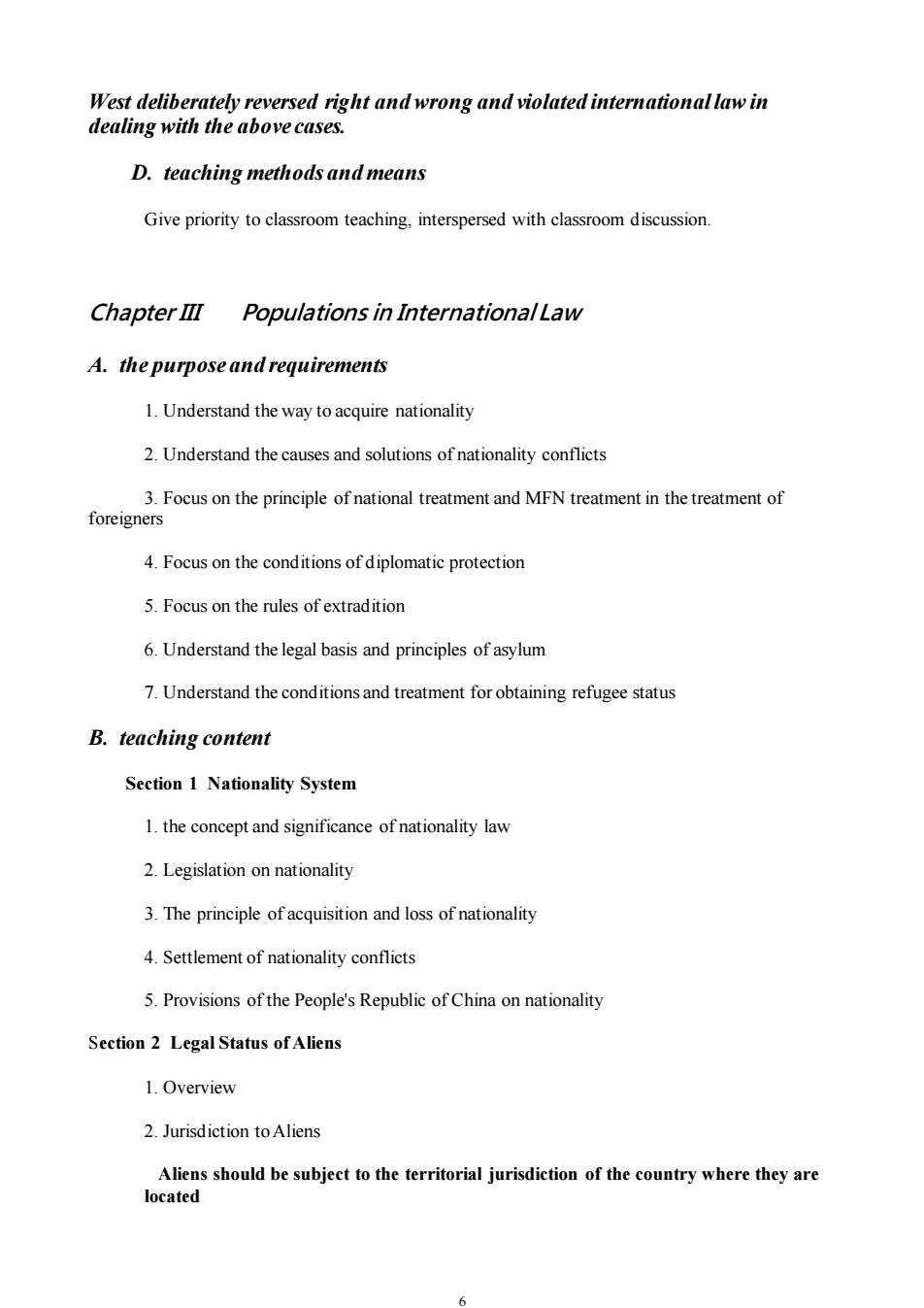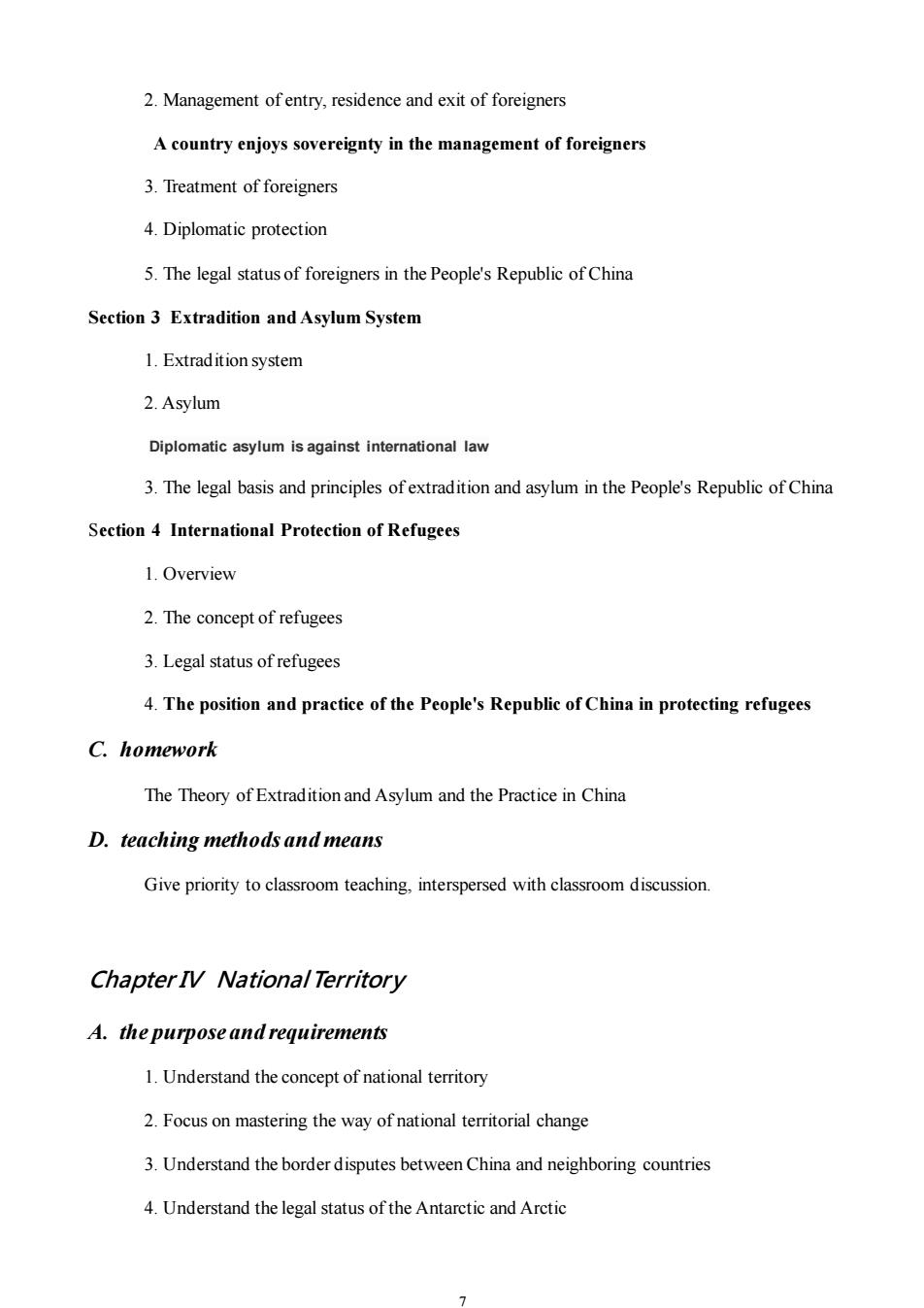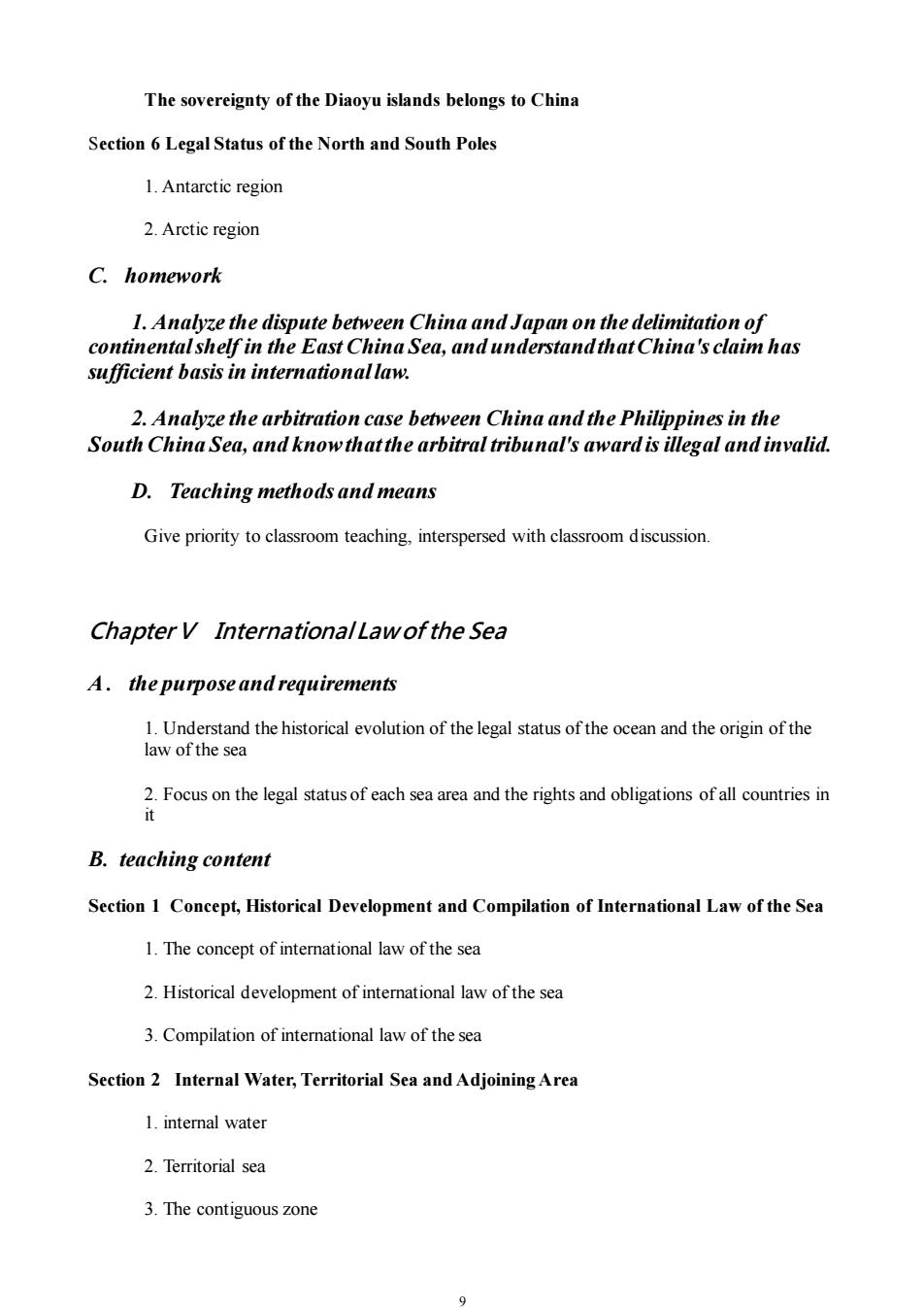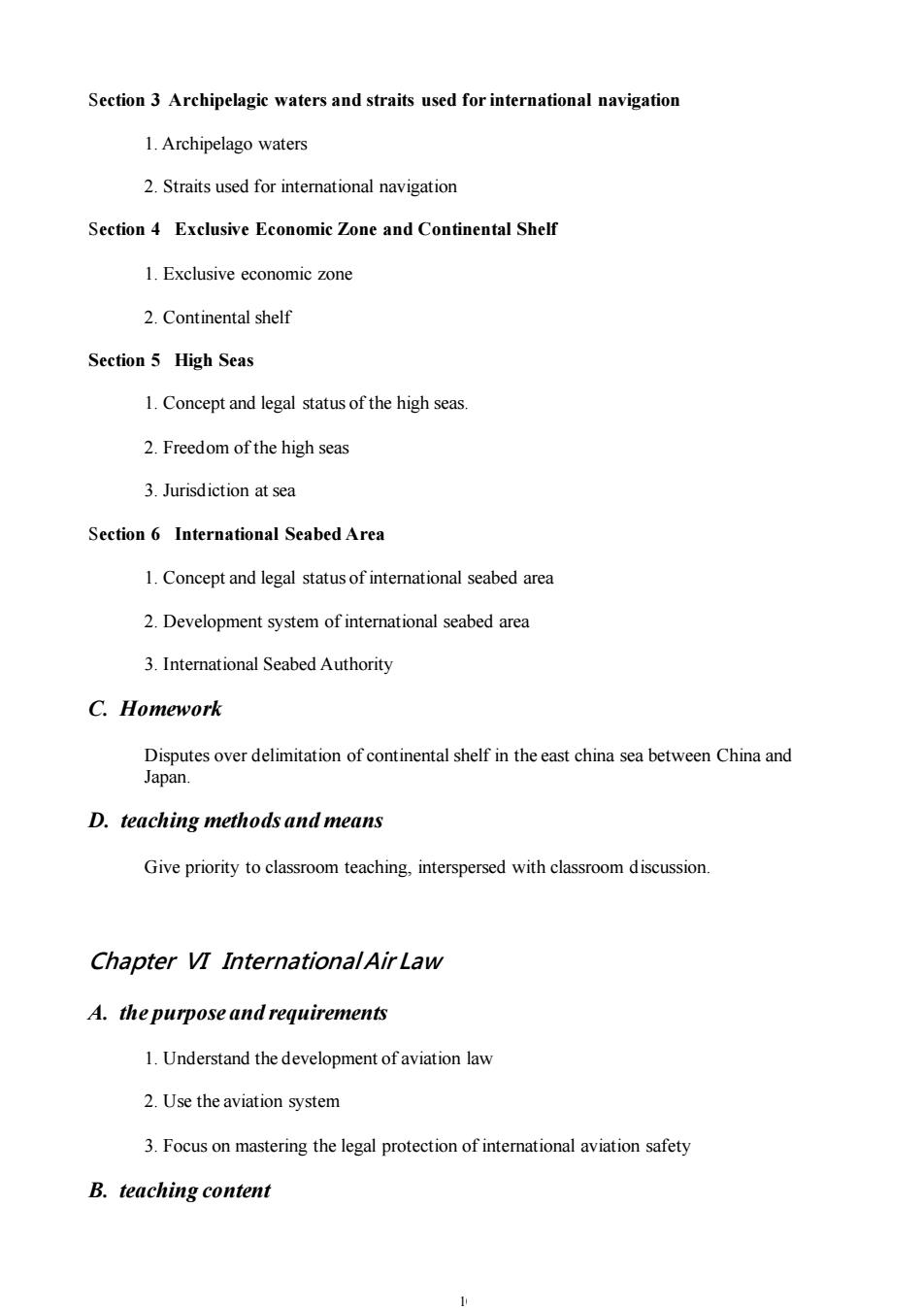
West deliberately reversed right and wrong and violated international law in dealing with the above cases. D.teaching methods and means Give priority to classroom teaching,interspersed with classroom discussion Chapter III Populations in InternationalLaw A.the purpose and requirements 1.Understand the way to acquire nationality 2.Understand the causes and solutions of nationality conflicts 3.Focus on the principle of national treatment and MFN treatment in the treatment of foreigners 4.Focus on the conditions of diplomatic protection 5.Focus on the rules of extradition 6.Understand the legal basis and principles of asylum 7.Understand the conditions and treatment for obtaining refugee status B.teaching content Section 1 Nationality System 1.the concept and significance of nationality law 2.Legislation on nationality 3.The principle of acquisition and loss of nationality 4.Settlement of nationality conflicts 5.Provisions of the People's Republic of China on nationality Section 2 Legal Status of Aliens 1.Overview 2.Jurisdiction toAliens Aliens should be subject to the territorial jurisdiction of the country where they are located
6 West deliberately reversed right and wrong and violated international law in dealing with the above cases. D. teaching methods and means Give priority to classroom teaching, interspersed with classroom discussion. Chapter III Populations in International Law A. the purpose and requirements 1. Understand the way to acquire nationality 2. Understand the causes and solutions of nationality conflicts 3. Focus on the principle of national treatment and MFN treatment in the treatment of foreigners 4. Focus on the conditions of diplomatic protection 5. Focus on the rules of extradition 6. Understand the legal basis and principles of asylum 7. Understand the conditions and treatment for obtaining refugee status B. teaching content Section 1 Nationality System 1. the concept and significance of nationality law 2. Legislation on nationality 3. The principle of acquisition and loss of nationality 4. Settlement of nationality conflicts 5. Provisions of the People's Republic of China on nationality Section 2 Legal Status of Aliens 1. Overview 2. Jurisdiction toAliens Aliens should be subject to the territorial jurisdiction of the country where they are located

2.Management of entry,residence and exit of foreigners A country enjoys sovereignty in the management of foreigners 3.Treatment of foreigners 4.Diplomatic protection 5.The legal status of foreigners in the People's Republic of China Section 3 Extradition and Asylum System 1.Extradition system 2.Asylum Diplomatic asylum is against international law 3.The legal basis and principles of extradition and asylum in the People's Republic of China Section 4 International Protection of Refugees 1.Overview 2.The concept of refugees 3.Legal status of refugees 4.The position and practice of the People's Republic of China in protecting refugees C.homework The Theory of Extradition and Asylum and the Practice in China D.teaching methods and means Give priority to classroom teaching.interspersed with classroom discussion. Chapter IV National Territory A.the purpose and requirements 1.Understand the concept of national territory 2.Focus on mastering the way of national territorial change 3.Understand the border disputes between China and neighboring countries 4.Understand the legal status of the Antarctic and Arctic
7 2. Management of entry, residence and exit of foreigners A country enjoys sovereignty in the management of foreigners 3. Treatment of foreigners 4. Diplomatic protection 5. The legal status of foreigners in the People's Republic of China Section 3 Extradition and Asylum System 1. Extradition system 2. Asylum Diplomatic asylum is against international law 3. The legal basis and principles of extradition and asylum in the People's Republic of China Section 4 International Protection of Refugees 1. Overview 2. The concept of refugees 3. Legal status of refugees 4. The position and practice of the People's Republic of China in protecting refugees C. homework The Theory of Extradition and Asylum and the Practice in China D. teaching methods and means Give priority to classroom teaching, interspersed with classroom discussion. Chapter IV National Territory A. the purpose and requirements 1. Understand the concept of national territory 2. Focus on mastering the way of national territorial change 3. Understand the border disputes between China and neighboring countries 4. Understand the legal status of the Antarctic and Arctic

B.Teaching content Section 1 State territory and territorial sovereignty 1.the meaning and importance of territory 2.The concept,nature and content ofterritorial sovereignty 3.Restrictions on territorial sovereignty Section 2 Components of State territory 1.Composition of territory 2.Territorial land 3.territorial waters 4.Airspace 5.subsoil Section 3 Ways of changing national territory 1.the meaning of the change of national territory 2.Ways of territorial change in traditional international law Compulsory cession and conquest are considered to violate modern international law 3.Ways of territorial change in modem interational law Section 4 National boundaries and borders 1.The concept of borde 2.The formation and division of borders 3.Settlement of border disputes 4.Border system Section 5 China's territory and borders 1.China's territory 2.China's border China does not recognize the illegal McMahon Line China has sovereignty over the South China Sea Islands and their adjacent waters
8 B. Teaching content Section 1 State territory and territorial sovereignty 1. the meaning and importance of territory 2. The concept, nature and content of territorial sovereignty 3. Restrictions on territorial sovereignty Section 2 Components of State territory 1. Composition of territory 2. Territorial land 3. territorial waters 4. Airspace 5. subsoil Section 3 Ways of changing national territory 1. the meaning of the change of national territory 2. Ways of territorial change in traditional international law Compulsory cession and conquest are considered to violate modern international law 3. Ways of territorial change in modern international law Section 4 National boundaries and borders 1. The concept of border 2. The formation and division of borders 3. Settlement of border disputes 4. Border system Section 5 China's territory and borders 1. China's territory 2. China's border China does not recognize the illegal McMahon Line China has sovereignty over the South China Sea Islands and their adjacent waters

The sovereignty of the Diaoyu islands belongs to China Section 6 Legal Status of the North and South Poles 1.Antarctic region 2.Arctic region C.homework 1.Analyze the dispute between China and Japan on the delimitation of continentalshelf in the East China Sea,and understandthat China's claim has sufficient basis in international law 2.Analyze the arbitration case between China and the Philippines in the South China Sea,and know that the arbitral tribunal's award is illegal and invalid. D.Teaching methods and means Give priority to classroom teaching,interspersed with classroom discussion Chapter V InternationalLawof the Sea A.the purpose and requirements 1.Unde hthesrc evoofhtatus ofthe ocenand the oigin of the B.teaching content Section 1 Concept,Historical Development and Compilation of International Law of the Sea 1.The concept of international law of the sea 2.Historical development of intemational law of the sea 3.Compilation of interational law of the sea Section 2 Internal Water,Territorial Sea and Adjoining Area 1.internal water 2.Territorial sea 3.The contiguous zone
9 The sovereignty of the Diaoyu islands belongs to China Section 6 Legal Status of the North and South Poles 1. Antarctic region 2. Arctic region C. homework 1. Analyze the dispute between China and Japan on the delimitation of continental shelf in the East China Sea, and understand that China's claim has sufficient basis in international law. 2. Analyze the arbitration case between China and the Philippines in the South China Sea, and know that the arbitral tribunal's award is illegal and invalid. D. Teaching methods and means Give priority to classroom teaching, interspersed with classroom discussion. Chapter V International Law of the Sea A . the purpose and requirements 1. Understand the historical evolution of the legal status of the ocean and the origin of the law of the sea 2. Focus on the legal status of each sea area and the rights and obligations of all countries in it B. teaching content Section 1 Concept, Historical Development and Compilation of International Law of the Sea 1. The concept of international law of the sea 2. Historical development of international law of the sea 3. Compilation of international law of the sea Section 2 Internal Water, Territorial Sea and Adjoining Area 1. internal water 2. Territorial sea 3. The contiguous zone

Section 3 Archipelagic waters and straits used for international navigation 1.Archipelago waters 2.Straits used for international navigation Section 4 Exclusive Economic Zone and Continental Shel 1.Exclusive economic zone 2.Continental shelf Section 5 High Seas 1.Concept and legal status of the high seas. 2.Freedom ofthe high seas 3.Jurisdiction at sea Section 6 International Seabed Area 1.Concept and legal status of international seabed area 2.Development system of international seabed area 3.International Seabed Authority C.Homework Disputes over delimitation of continental shelf in the east china sea between China and Japan. D.teaching methods and means Give priority to classroom teaching,interspersed with classroom discussion. Chapter VI InternationalAir Law A.the purpose and requirements 1.Understand the development of aviation law 2.Use the aviation system 3.Focus on mastering the legal protection of international aviation safety B.teaching content
10 Section 3 Archipelagic waters and straits used for international navigation 1. Archipelago waters 2. Straits used for international navigation Section 4 Exclusive Economic Zone and Continental Shelf 1. Exclusive economic zone 2. Continental shelf Section 5 High Seas 1. Concept and legal status of the high seas. 2. Freedom of the high seas 3. Jurisdiction at sea Section 6 International Seabed Area 1. Concept and legal status of international seabed area 2. Development system of international seabed area 3. International Seabed Authority C. Homework Disputes over delimitation of continental shelf in the east china sea between China and Japan. D. teaching methods and means Give priority to classroom teaching, interspersed with classroom discussion. Chapter VI International Air Law A. the purpose and requirements 1. Understand the development of aviation law 2. Use the aviation system 3. Focus on mastering the legal protection of international aviation safety B. teaching content